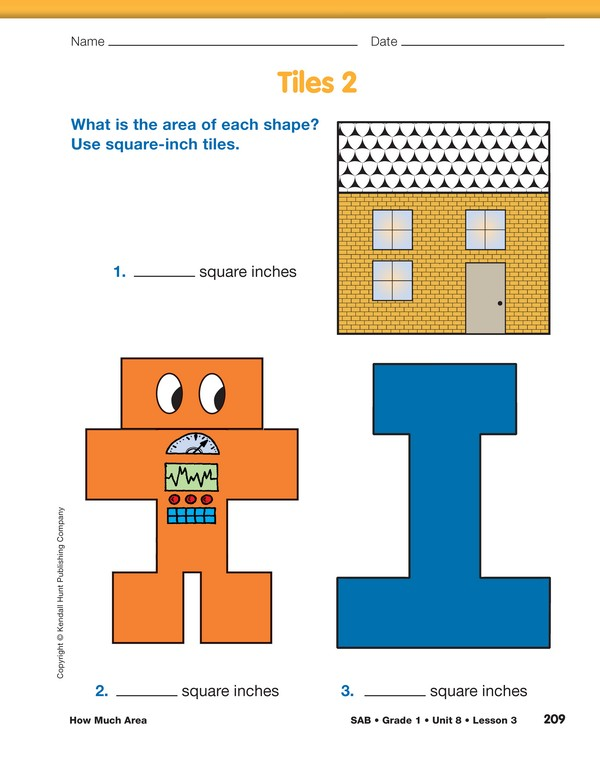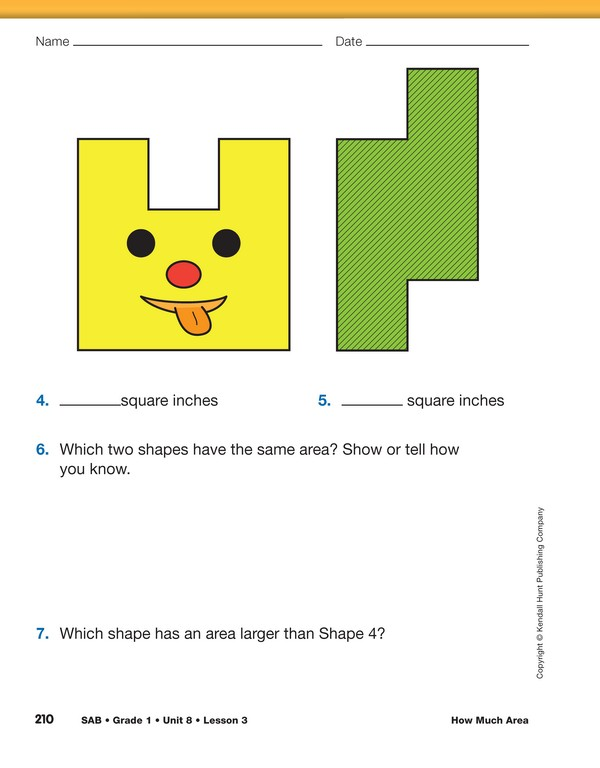Ask students to compare the areas of all the shapes
on the Tiles 1 page using comparison language such
as “greater than,” “less than,”
and “equal to” and
prompts similar to the following:
- Which shape has the largest area? (Shape 2)
- So we can say that the area of Shape 2 is greater than any other shape.
- Do any two shapes have the same area?
(Yes—Shapes 3 and 4, Shapes 5 and 8, as well as Shapes 6 and 7.) Do they have the same shape? (no)
- Finish each sentence.
The area of Shape 3 is equal to the area of
Shape _____ . (4)
The area of Shape 6 is equal to the area of
Shape _____ . (7)
The area of Shape 5 is equal to the area of
Shape _____ . (8)
- What does the word “equal” mean? (Equal means the same number or quantity.)
- Look at each pair of shapes that have the same area. Can shapes be different but have the same
area? (Yes, different shapes can have the same area.)
- Finish each sentence.
The area of Shape _____ is less than the area of
Shape 2. (all shapes)
The area of Shape _____ is less than the area of
Shape 6. (Shapes 1, 3, 4, 5, 8)
The area of Shape 5 is less than the area of
Shape _____ . (Shapes 2, 3, 4, 6, 7)
- Let’s pretend for a minute. If Shape 7 is a dog, would Shape 4 make a good bed for him? Tell how
you know. (No, because the area of Shape 7 is seven square inches and Shape 4 is only five square inches so all of him wouldn’t fit.)
- That’s right, all of him wouldn’t fit because four square inches is less than seven square inches.
- Which shape would make a better bed for the dog? Tell how you know. (Possible response: Shape 2 would work best, it’s the biggest. Shape 7 is
seven square inches like Shape 6, but that’s the same with no extra room. No shapes have 8 square inches, so only nine square inches is bigger than the dog.)
- Finish each sentence.
The area of Shape 4 is greater than the area of
Shape _____ . (Shapes 1, 5, or 8)
The area of Shape 7 is greater than the area
of Shape _____ . (Shapes 1, 3, 4, 5, 8)
Distribute square-inch tiles to each student and provide time for them to complete the Tiles 2 pages in
the Student Activity Book. Students should work on these questions independently.
Use the Tiles 2 pages in the Student Activity Book to determine whether students can accurately measure the
areas of shapes by covering them with square-inch tiles [E6]; compare the areas of different shapes [E1]; and recognize that different shapes can have the same areas [E4].















